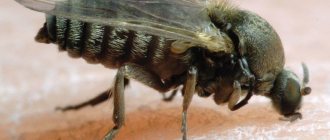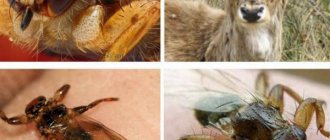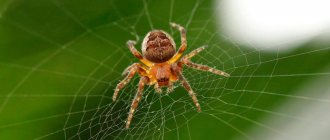Appearance of two-way
Double-tailed animals have a white elongated body, devoid of pigmentation. Only the cerci, paired outgrowths at the end of the abdomen, may be slightly darkened. In many species they have a menacing appearance and resemble claws.
Forktails are ancient creatures. Scientists believe that their origin began in the Carboniferous period. This may be why these representatives have a primitive structure.
The two-east has no eyes. They are completely blind, but are well oriented in space thanks to their long, segmented antennae. The antennae have a straight, not curved shape and are directed forward. Typically, the antennae are between half and one-quarter the length of the body.
All creatures of this order have 3 pairs of legs. They are colorless and short, starting on the first two segments of the abdomen. The entire abdomen consists of as many as 10 segments - thus, the legs of the double tail are located closer to the head. These creatures do not have wings.
The size of two-easted birds living in Russia does not exceed 2-5 mm. But in tropical countries there are giant individuals with a body length of up to 5 cm.
Habitat
The habitat of the two-east covers middle and tropical latitudes throughout the globe, except for deserts, mountainous and arid areas. The vast majority of representatives of the order live in America, but many species are also found in central Russia.
In nature, doubletails live in moist soil, but avoid wetlands. Their favorite places are fallen, rotting trees, wet slopes near streams and ponds, as well as the lower tier of a dense forest, where the sun's rays do not reach due to dense branches. It is easy to detect double-easted fish if you turn over a rotten snag or dig up the ground on the river bank.
Unfortunately, double-tailed birds often settle near humans. They love rooms with high humidity and poor ventilation, so they can live in basements, bathrooms, and under baseboards. It is not easy to detect uninvited guests, since these creatures leave the shelter only at night. Due to their small size and lack of pigmentation, they are invisible. Therefore, two-tailed birds can live in a house for several years, and the owner will not be aware of their presence.
Nutrition
Twotails feed on humus, but some representatives are predatory and can catch small insects, crustaceans, springtails and other invertebrates living near them. Predatory species of two-easted (pictured above) have cerci that resemble claws. With the help of these projections they grab and hold prey. Herbivorous two-tails (pictured below) have long and straight tail extensions, since they do not need to hunt for food.
Two-tails also eat mycelium threads, microscopic mites, eggs and larvae of insects, berries, young and decaying shoots. Hexapods feed in the dark, finding food with the help of sensitive antennae. They can take food underground to eat during the day. But when the sun's rays appear on the soil surface, the two-tailed plants do not appear.
Life cycle and reproduction
Two-tailed animals are dioecious animals. In all representatives of the order, fertilization is external: the male deposits spermatophores on the soil, the female finds them thanks to special pheromones - the odors that they emit. The female then collects spermatophores and plunges into the soil. Having prepared a cavity for her clutch, she lays eggs.
Unlike many insects, two-tailed insects do not undergo metamorphosis. The eggs hatch into individuals that look similar to adults, but are smaller in size. However, there are still slight differences in the structure of the little two-tailed birds from their parents: they have fewer segments on the abdomen, and many of their organs are not yet developed.
During the process of growth, two-tails molt - they shed the old chitinous shell and form a new, larger one. This process is due to the fact that the chitinous shell cannot increase with the growth of the host. Therefore, arthropods are forced to change it.
Reproduction of two-easted birds occurs in the warm season. These arthropods are very prolific: the female lays over 100 eggs at a time.
Origin of the species and description
Photo: Two-tailed
This arthropod is included in the class of cryptomaxillary, uniting the most primitive creatures that lead a very secretive lifestyle, and are closely related to the soil, except for the two-tailed, this class includes the non-jawed, springtails. What these three species have in common is that their mouthparts are retracted into the head capsule, hence their name.
Video: Double-tailed
Previously, this subclass belonged to insects, but now it has been identified as a separate class. Individuals of the order Two-East are closest to insects. They are larger than other representatives of the cryptomaxillary species: protur and springtail. How hexapods developed historically is poorly understood. But one species of two-easted fish is known, dating back to the Carboniferous period - Testajapyx. The individuals had compound eyes, as well as a mouthpart similar to that of real insects, in this they are closer to them than to modern representatives of Diplura.
This species has three large groups:
- Campodeoidea;
- Japygoidea;
- Projapygoidea.
The most widespread are:
- family Campodia;
- Japix family.
Natural enemies
The two-easted bird has many enemies in nature. Birds readily peck at them - perhaps this is one of the reasons why these creatures are nocturnal. But danger awaits them in the soil too. Shrews and moles willingly feast on two-tailed fish and destroy their clutches.
These creatures are also destroyed by soil insects, for example mole crickets. The predatory larvae of many beetles also destroy two-easted beetles. But these creatures deftly avoid natural enemies, as they quickly move between particles of the earth thanks to three pairs of short but strong legs.
Two-tailed fish can exhibit cannibalism, eating small fellows of their own or other species. This is especially true for predatory representatives of the order.
What does a double tail look like, photo
The double-tailed bird (also known as an earwig) is an insect from the order Leatherwings, ranging from 7 to 50 mm in length. The double-tailed wing has 2 pairs of wings, but the upper one is shortened and is, rather, a rigid elytra, and the back one is membranous or absent altogether.
The insect got its name (two-tailed) for the characteristic pair of “claws” at the end of the body. The color is dark brown, brown, sometimes black. In the territory of the former USSR, the European earwig (mite) is mainly widespread.
The insect leads a nocturnal, secretive lifestyle. The main diet is organic remains of animal and plant origin, as well as small organisms.
Loves humidity, lives under stones in rotten leaves, as well as in secluded corners of human dwellings.
INTERESTING . There are forktails, which are vaguely similar to earwigs, but these insects represent different orders. Although in the scientific classification it is the forktails that are “real two-tails.”
Does the double-tailed snake bite and why is its bite dangerous?
Predatory representatives of the order are capable of biting a person - squeezing the skin with their claws. The cerci are so strong that this little creature can tear the skin. And since these creatures live in damp, polluted places and feed on fungi and spoiled food, inflammation can develop in the wounds.
The bite of the double tail is quite painful. How can one understand that it was the two-tailed one that bitten if the room was dark or the person did not immediately pay attention to the stabbing pain? There is one characteristic sign: on the damaged area of the skin there will be not one, but two small wounds with a distance of 1-2 millimeters between them. Soon after being bitten, they begin to itch and swell.
What to do if bitten by a two-tailed fish? Fortunately, these creatures are not poisonous. But the wound cannot be ignored. It needs to be disinfected quickly. If a person is prone to allergies, it is advisable to take an antihistamine.
Harm and danger to humans
Is double-tailed beetle dangerous for humans? The insects themselves are harmless. The maximum that can happen is that the earwig will bite a person with its forked claw, but this bite is not strong and does not lead to illness. Two-tailed insects do not settle in food supplies and do not spoil things, like various bugs in cereals or food moths. But their frequent appearance in the bathroom or kitchen indicates an increased level of humidity and poor ventilation of the premises.
The insect received the nickname “earwig” because it can crawl into the ear of a sleeping person. Previously, in the villages it was believed that in this way the nimble earwig crawls directly into the human brain. This, of course, is not true, but the very fact of the double-tailed penetrating the ear is extremely unpleasant.
Can it get into your ear?
Since childhood, many people know that the earwig crawls into the ear and pierces it. She then makes her way into the brain, where she raises her offspring. In fact, this is a common “urban legend”. The two-tailed fish, of course, can crawl into the ear and even bite a person tossing and turning in his sleep. But the likelihood of this is very, very small. With the same success, any insect can accidentally get into a person’s ear.
To summarize, we can say this: “An earwig can get into the ear, but only by accident.”
Do double tails spoil the harvest?
If the number of earwigs is not limited or these insects are not completely destroyed, then they can cause some damage to agriculture. In general, the earwig is more of a scavenger; it eats leaves, remains of animals, insects and plants. But in dry years, the insect turns its gaze to the fruits of fruit trees and berry bushes. It attacks apples, peaches, currants, cherries, etc.
The insect bites into the pulp of cracked and overripe fruits. It also leaves its excrement on fruits and berries.
The two-tailed insect can also attack vegetable crops. The leaves and fruits of beets, cucumbers, potatoes, tomatoes, etc. suffer.
IMPORTANT! Double-tailed insect causes damage to beekeeping. The insect makes its way into the hives, where it feeds on honey and beebread.
In the spring, earwigs are not averse to eating seedlings of tomatoes and peppers, as well as nibbling on indoor plants.
Do these insects bite?
The appendages at the end of the abdomen are used by the earwig for protection as well as for obtaining food. The two-tailed dog can bite with them if it senses danger emanating from you. The insect bites a person, but does it in self-defense.
In general, the insect is not poisonous, but since the earwig often feeds on carrion, it can spread the infection.
Often, after its bite, marks remain on the skin. An allergic reaction is possible: swelling, redness, itching. If you are hypersensitive to various allergens, be sure to take an antihistamine after a bite. If the consequences of the bite do not go away for too long, then consult a doctor.
Is double-tailed beetle dangerous for humans?
It is already clear from the previous section that two-tailed animals are by no means harmless creatures for people. But the danger of these creatures lies not only in possible bites.
If two-tails live in the bedroom, theoretically, such a creature could crawl into the ear when a person is sleeping. Once in the ear canal, the double tail will cause severe pain. In this case, boric acid will help. It is dripped into the ear, and soon the two-tailed one dies. A dead arthropod can be easily removed with a cotton swab. If you don’t have boric acid at hand, and some creature is moving in your ear, you can drop sunflower oil into the ear canal. It kills all arthropods, as it quickly fills the trachea through which these creatures breathe.
A repulsive appearance can also harm a person emotionally. The two-tailed bug can greatly frighten a child or a person who is afraid of insects. In addition, these creatures appear suddenly and run quickly, which enhances the frightening effect. And for some, the presence of insects in the house will not allow them to sleep peacefully.
Since two-tailed birds hide in damp and polluted places during the day, they can spread dangerous bacteria. After all, at night, while the owners of the house are sleeping, these creatures can walk around the kitchen table, food and clean cutlery in drawers. The threat lies in the fact that the hostess may not know about the dangerous neighborhood and only wonder why the child got sick or the guests were poisoned.
In the garden, doubletails also cause great harm. In the spring they destroy seedlings, and in the summer and autumn they eat berries, vegetables and fruits. Since arthropods appear at night, the garden owner may not even suspect who is spoiling his harvest. Doubletails love moist soil and therefore well-watered beds are an excellent refuge for them.
What is a double tail?
Double-tailed - this is how the insect was popularly called because of the strong chitinous outgrowths instead of a tail, called cerci. The correct term is earwig or forktail. It has an oblong segmented body of brown-red color with six legs. There are no eyes, and long antennae are located in front, reaching half of the insect's body.
It also has small wings, but the forktail rarely uses them and flies only short distances. Usually its size is modest: 2 or 3 cm, but there are also larger individuals that grow up to 7 cm. The cerci of all varieties are different: in medium-sized specimens they are small and relatively thin. The large ones have hard, powerful, claw-like claws, with which the two-tailed fish hunt springtails and small soil mites.
The doubletail settles in damp and cool places; it loves holes with humus. Two-tailed ducks are extremely agile and dexterous, move very quickly, hunt at night, not one at a time, but in flocks. Their diet is varied, the predator looks for larvae of small insects, microscopic mites and centipedes. He will not refuse the shoots and inflorescences of plants, fruits, vegetables, and will not disdain bread crumbs.
Penetrating into a living space, it hides in damp nooks, crevices between baseboards, boards, cracks in walls, and in the basements of houses. In apartments it hides in bathtubs and rooms with poor ventilation. Her presence in the house is not always immediately noticeable, because she goes out hunting at night and hides during the day.
Two-tailed and earwig - differences
The two-tailed bird is similar in appearance to the earwig, a representative of insects that has a similar body shape and the same forked cerci at the end of the abdomen. Therefore, the double-easted bird is often confused with the earwig. But in fact, these are different creatures that have little in common in structure and lifestyle.
An earwig, which is confused with the two-tailed earwig.
The earwig is always colored in brownish shades, while the two-tailed one is most often colorless (white) or light beige. There is one more difference: the two-tailed carapace is denser and wider, while the six-legged ones have a soft exoskeleton.
Is there any benefit from two-way?
There are no useless species in the wild. Two-tailed fish are part of the ecosystem and have a role in maintaining balance within it. These creatures are food for birds, insectivorous animals and invertebrate creatures. In turn, the two-tailed insects themselves also destroy many organisms, including forest pests and dangerous parasites - for example, ticks.
Two-tailed plants also play an important role as saprotrophs - little orderlies. They eat decaying plants, berries and dead insects. This is a very important ecological role, since without saprotrophs the cycle of substances in nature is impossible.
But near human habitation and on agricultural land there is no benefit from two-easters. Therefore, we need to fight them.
How to get rid of double-east in an apartment and a private house?
If double tails appear in an apartment or country house, first of all you need to examine all pipes and valves for leaks, check the ventilation and humidity level in the room. These creatures do not live in dry and well-ventilated rooms. Therefore, the very fact of the appearance of double tails is a sign that the house is too damp.
By the way, high air humidity is also harmful for the residents themselves. And in addition to small arthropods, a fungus may appear. Taking it out is much more difficult. Therefore, establishing a normal indoor microclimate is the main way to combat pests, which will also help get rid of related problems.
To reduce air humidity, do not dry clothes in the bathroom or kitchen. If condensation accumulates on the pipes, it must be removed regularly with a dry cloth. In addition, it is important to remove all places where two-tailed insects can hide and reproduce: seal cracks with sealant, look through hard-to-reach places under furniture and household appliances. Two-tailed ducks that live in houses and apartments feed on food waste, so the trash needs to be taken out every evening and food must be carefully covered.
In order to get rid of all arthropods in the house, you can use insecticides. But you need to use chemicals carefully if a person prone to allergies lives in the room.
To destroy arthropods without putting your health at risk, you can use special glue. It is applied to cardboard or paper around the delicacy for two-easts. These could be slightly rotten or simply overripe berries, pieces of banana or apple, as well as bread crumbs. The glue is placed overnight in the places where the double-east was found. In the morning they will already stick to the paper, and all that remains is to throw it away. Naturally, before putting out the bait, you need to clean up and remove garbage, all food and crumbs from the table.
But it’s important not to forget about sticky traps. If a child or pet steps on such a surface, it will not be easy to wash off the glue. Therefore, animals should not be allowed into the room, and children should be kept under supervision.
Eliminate dvuhostok using funds from the store
If traditional methods do not help get rid of double-easts, and do not reduce their number in a week, you will have to use chemicals. On women's forums, the following are recommended more than others:
1. Repellent for creeping insects “Clean House”
Repellent for creeping insects “Clean House”
The manufacturer promises:
- cockroaches, flies, wasps, ants and two-tailed insects will disappear from the house in a few days.
Pros:
- Good price . Compared to other aerosols of this type, “Clean House” is not the most expensive product.
- Nice smell . This spray does not have a chemical smell, but you still need to ventilate after using it.
- Efficiency . This spray effectively copes with its task, ridding the house of an entire family of insects in several approaches.
Minuses:
- Chemistry. This product contains substances hazardous to human health and pets, so you can use it only with a mask and gloves, wash your hands well and rinse your mouth after use. It is better to take your pets away during treatment.
Review:
Anya2069:
I forgot about what cockroaches are since the early 2000s. My opinion was that there are simply no cockroaches in our city. None of my acquaintances or friends had them. Imagine my surprise when we moved into a new four-room apartment. The corpses of these reptiles fell from under the wallpaper, began to open the baseboards, mountains of swarming cockroaches ((it was a real nightmare. Before the major renovation of the apartment, they decided to get rid of these unpleasant neighbors. I arrived at the store and asked for some miracle remedy. I thank the seller that she advised me this gorgeous aerosol Clean House. The price is 320 rubles for 600 ml. Having put on a protective mask and gloves, I began to process the apartment. For 80 square meters of the apartment, 3 bottles of aerosol were used. After 3 days they came to check, they saw mountains of corpses of cockroaches. Now 2 have passed weeks, I haven’t seen even a single tiny live cockroach, which I’m incredibly happy about. By the way, the instructions say that this aerosol also effectively fights bedbugs, flies, moths, and wasps. By the way, a big plus is that the aerosol has a pleasant smell. But it’s still better wear a protective mask.
Source irecommend.ru
2. Insect chalk “Mashenka”
Insect chalk "Mashenka"
The manufacturer promises:
- insects are afraid of “Mashenka” like fire.
Review:
Mc_masenag:
For those who don’t want to read the entire review, here’s a short summary: cockroaches were discovered a week ago. Yesterday Mashenka drew the baseboards under the sink and the back of the roll-out drawers in the kitchen. This morning the whole kitchen is upside down.
Source irecommend.ru











